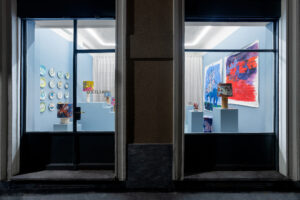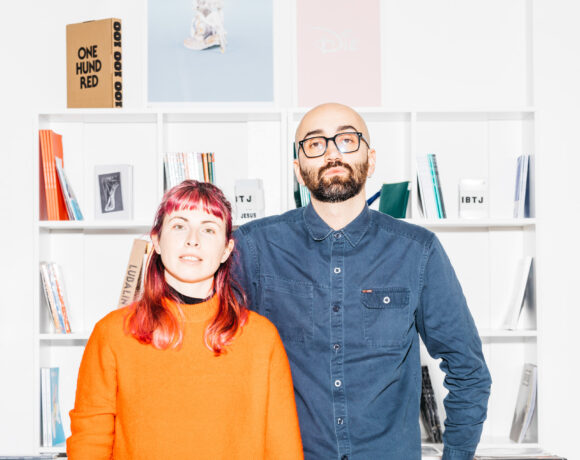Lucifer, Flaminia Veronesi’s solo exhibition at the Oxilia Gallery visible until 20th December 2022, is the embodiment of the gallerists Frederik De Wachter and Alessandro Mensi’s mission: to put in contact art works, handcraft items and design to return composite visions, under the sign of a contemporary and unprecedented gaze.

Veronesi has accustomed her public to an unmatched creative abundance, which is reaffirmed and even enriched with Lucifer. The exhibition is composed by numerous artist’s objects that include: a stool paired with a small table, by which we feel observed because of the winged creatures painted on the surface; candle-holders, which resemble tiny and fleeting fairy environments; then glasses, lamps, and dishes. On two huge canvases, a centaur and a mermaid stand out: the first one is painted in an unspecified hilly landscape, while the second one lies in an infernal night. The particular treatment reserved for each type of object on display reconfirms the artist’s wise and playful use of materials.


What strongly unites these artworks are the liquid and winding strokes that compose the figures: thanks to them, images linked to ancient iconographies and mythologies come back, acquiring a contemporary awareness, which suggest the visitor to embrace a freer and more carefree mindset. The strokes’ fluidity is also sign of perpetual transformation that affects every painted figure: one line, ideally always the same, unites centaurs, harpies, mermaids, plants and undefined creatures, which are bound together by formal and emotional connections. The hierarchical and anthropogenic gap between man and everything else is shattered under the artist’s brush strokes, who on the contrary promotes a renewed and more genuine union between human and the world. This creative aim pinpoints the artist’s ability to recognize – getting out from herself and carefully observing through her mesmerizing universe – that we are in fact wrapped in a bigger picture, where the state of separation is just an illusion. Thus, Veronesi sabotages a certain modern stiffness, to make room for a vital and symbolic reality, also made up of loved objects.

In fact, the sincere affection that this exhibition emanates is especially perceived between the artist and the displayed objects, which are the result of joint effort and positive compatibilities. The artist decorates, through the “maiolica” technique, several terracotta dishes, made with the technical support of Roberto Aponte, who’s a designer and ceramist inspired by the Mediterranean tradition. These very lively pieces remind a Carnival, a parade, a Medieval bestiary, together with the joy that springs from a set table. Veronesi also engraves several Murano glasses: these charming heterochromatic stem glasses greatly express the artist’s accuracy, reminding that, also a savage, fierce, and fervid imaginary can be paired with something extremely fragile and delicate, reaching a remarkable level of competence, both form the technical and content points of view. Lastly, she intervenes on lamps from the Roma and Sonora collections from the new Pugliese brand Nassi, founded by Francesca De Giorgi, decorating the lampshades. In particular, these lamps represented for the artist an inner challenge: “Why the light they emanate makes me feel so good?” Veronesi asked herself when she met these lamps.

This attraction fascinated the artist: it pushed her to reflect on the nature of the light that these objects released. Her answer includes the will to operate on the lampshades, which were filled by a great variety of scenes – from a bizarre and suggestive cat, to rearranged Biblical scenes, to enveloping flowers, to, finally, a fallen angel, who names the entire exhibition. In this way, the objects have acquired attractive and very colourful features that clash with the marble bases – which already underwent a careful selection by the brand – creating a reasoned contrast of surfaces and patterns. The sum of these actions pushed Veronesi to ponder over how the domestic objects enter in our daily life and how they enrich it. From anonymous tools they become comforting presences, which are gradually dignified by those ordinary, affectionate, and repeated gestures that we dedicated to them. Veronesi, in the guise of a modern Lucy – this time, with her eyes in their place, wide open and attentive – imagines and portrays an eclectic and confident contemporaneity: a space where a glass can turn into a flowery mermaid or a pink dolphin at any moment. However, these objects, or companions, will always enjoy our esteem.
Info:
Flaminia Veronesi. Lucifero
until 20/12/2022
Oxilia Gallery
via Nino Oxilia 9, Milano
For all the images: Flaminia Veronesi, Lucifero, installation view, Oxilia Gallery, Ph. T-Space, courtesy Oxilia Gallery, Milano

Eleonora Savorelli (Jesi, 1996) is an independent curator based in Milan. After graduating from John Cabot University, in Rome, with a Major in Art History and Minors in Entrepreneurship and Classical Studies, she attended the two-years program of Visual Arts and Curatorial Studies at Naba, in Milan. At the moment, she is working at the Milanese gallery BUILDING, where she is the exhibition coordinator. At the same time, she writes for several online magazines, among which: Kabul Magazine, C41 Magazine, Forme Uniche and Artribune.






NO COMMENT